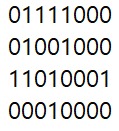| 일 | 월 | 화 | 수 | 목 | 금 | 토 |
|---|---|---|---|---|---|---|
| 1 | 2 | 3 | 4 | 5 | 6 | 7 |
| 8 | 9 | 10 | 11 | 12 | 13 | 14 |
| 15 | 16 | 17 | 18 | 19 | 20 | 21 |
| 22 | 23 | 24 | 25 | 26 | 27 | 28 |
| 29 | 30 |
Tags
- 내휴학생활중의아주큰일
- git
- 대학원일기
- MSBuild
- level4
- SWEA
- level1
- Matrix Factorization
- 안드로이드스튜디오
- py
- java
- 파이썬
- level3
- 대학원
- BFS
- build
- 다시풀기
- 컨트리뷰톤
- 휴학
- SQL
- WebOS
- 컴퓨터비전
- androidstudio
- 자바
- D3
- LEVEL2
- Github
- Python
- 어렵다
- 프로그래머스
Archives
- Today
- Total
bit가 눈 앞에서 왔다갔다
Py) 프로그래머스 77485 행렬 테두리 회전하기 본문

https://school.programmers.co.kr/learn/courses/30/lessons/77485
프로그래머스
코드 중심의 개발자 채용. 스택 기반의 포지션 매칭. 프로그래머스의 개발자 맞춤형 프로필을 등록하고, 나와 기술 궁합이 잘 맞는 기업들을 매칭 받으세요.
programmers.co.kr
1차: 3시간?
2차: 40분
0. 입출력

1. 김예고리즘
1-1 로직
1) map 생성
2) deq에 rotation 해줘야하는 애들 모아서 append 시켜놓고 left에서 pop한 것을 append
3) 순서가 바뀐 deq을 원래 map에 대입
4) 반복
1-2. 알고리즘 -> 다시 할 예정
'''
rows x columns, 회전들의 목록 queries 주어짐
시계방향으로 회전, 정수 4개로 표현
회전들을 배열에 적용, 위치가 바뀐 숫자 중 작은 숫자 순서대로 배열에 -> return
----
회전하는 숫자들을 어떻게 잡아줘야하지?
배열 4개 생성
2 2 5 4
x1~y1 / y1~y2 / x2~y2 / x1~x2
2~2/ 2~4/ 2~4/ 2~5
'''
from collections import deque
def solution(rows, columns, queries):
answer = []
map = []
deq = deque()
cnt = 1
for i in range(rows):
map.append([])
for j in range(columns):
map[i].append(cnt)
cnt += 1
min_v=[]
for q in queries:
x1, y1, x2, y2 = q
for k in range(y2-y1):
deq.append(map[x1-1][y1-1+k])
for a in range(x2-x1):
deq.append(map[x1-1+a][y2-1])
for k in range(y2-y1):
deq.append(map[x2-1][y2-1-k])
for a in range(x2-x1):
deq.append(map[x2-1-a][y1-1])
print(deq)
min_v.append(min(deq))
tmp = deq.pop()
deq.appendleft(tmp)
print(deq)
c = 0
for k in range(y2-y1):
map[x1-1][y1-1+k] = deq[k]
c+=1
for a in range(x2-x1):
map[x1-1+a][y2-1] = deq[c+a]
c+=1
for k in range(y2-y1):
map[x2-1][y2-1-k] = deq[c+k]
c+=1
for a in range(x2-x1-1):
map[x2-1-a][y1-1] = deq[c+a]
c+=1
print(map)
print(min_v)
break
return answer
print(solution(6,6,[[2,2,5,4],[3,3,6,6],[5,1,6,3]]))그동안 내가 푼 문제 중 최악인거 같다.
2. Solution
2-1. 사용 자료구조 및 알고리즘: x
2-2. 로직
1) 행렬의 각 꼭짓점을 temp1~3에 각각 저장해 min 값을 추리고
2) 행렬의 각 면을 범위를 지정해 시계방향으로 한칸씩 당겨준 뒤 min값을 추리고
3) 이동한 temp의 위치에 맞게 올바른 답을 대입해줌
2-3. 코드 --> 수정예정
def solution(rows, columns, queries):
answer = []
# 1:00
graph = [list(range(1+(i*columns), 1+(i*columns)+columns)) for i in range(rows)]
# list니까 []로 하는게 맞음. 괄호 생각 잘하자
for query in queries:
x1, y1, x2, y2 = query
temp1 = graph[x1-1][y2-1]
temp2 = graph[x2-1][y2-1]
temp3 = graph[x2-1][y1-1]
ans = min(temp1, temp2, temp3)
for i in range(x1-1, x2-1):
graph[i+1][y2-1] = graph[i][y2-1]
ans = min(graph[i+1][y2-1], ans)
for i in range(y2-1, y1-1, -1):
graph[x2-1][i-1] = graph[x2-1][i]
ans = min(graph[x2-1][i-1], ans)
for i in range(x2-1, x1-1, -1):
graph[i][y2-1] = graph[i-1][y2-1]
ans = min(graph[i][y2-1], ans)
for i in range(y2-1, y1-1, -1):
graph[x1 - 1][i] = graph[x1 - 1][i - 1]
ans = min(graph[x1 - 1][i], ans)
graph[x1][y2-1]=temp1
graph[x2-1][y2-2]=temp2
graph[x2-2][y1-1]=temp3
answer.append(ans)
return answer
print(solution(6,6,[[2,2,5,4],[3,3,6,6],[5,1,6,3]]))
반응형
'Algorithm > Prob' 카테고리의 다른 글
| Py) SWEA 1859 백만장자 프로젝트 (1) | 2022.11.02 |
|---|---|
| Py) 프로그래머스 77484 로또의 최고 순위와 최저 순위 (0) | 2022.07.16 |
| Py) 72411 메뉴 리뉴얼 (0) | 2022.07.07 |
| Py) 프로그래머스 1844 게임 맵 최단거리 (0) | 2022.06.22 |
| Py) 프로그래머스 12978 (0) | 2022.06.04 |
Comments



